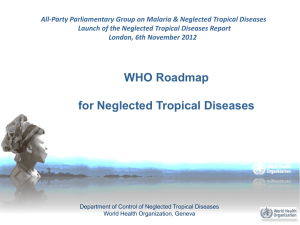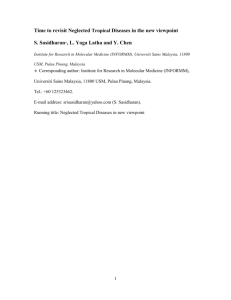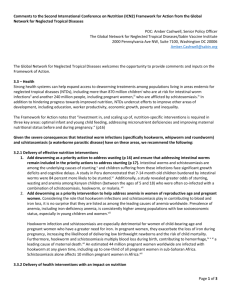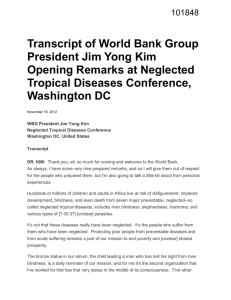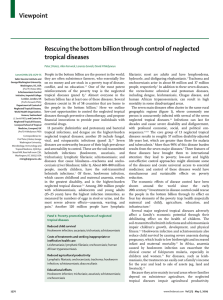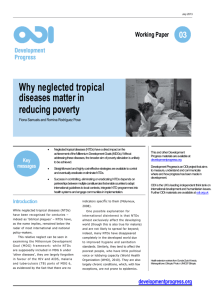Global Network for NTDs Comment Form FINAL 3 21 2014
advertisement
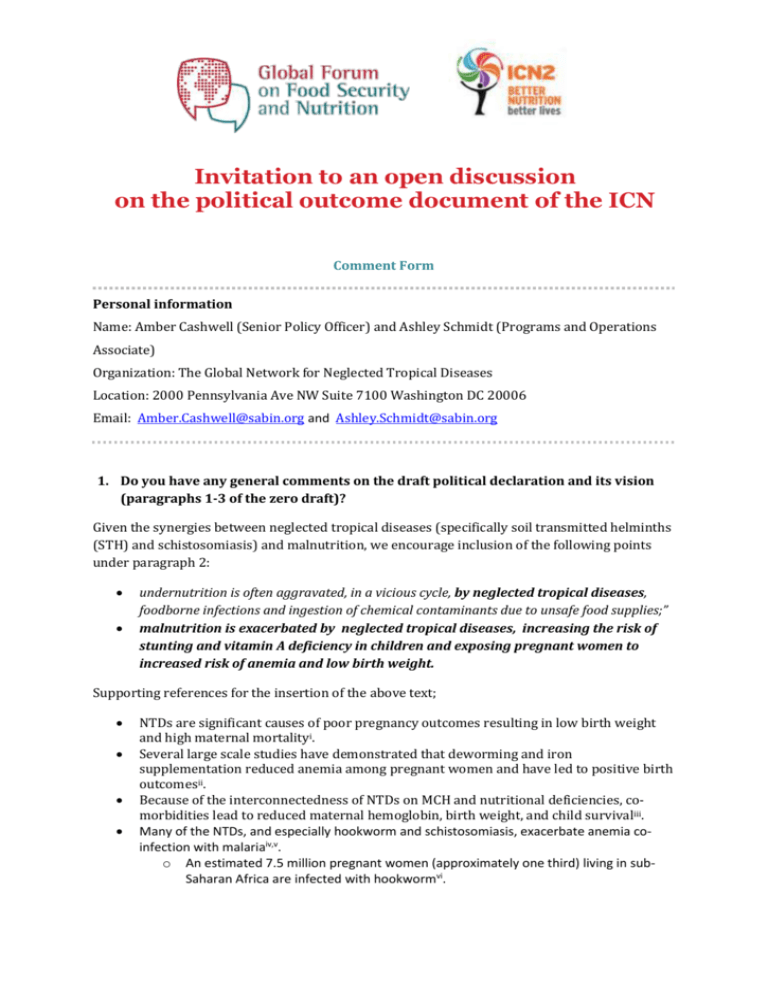
Invitation to an open discussion on the political outcome document of the ICN Comment Form Personal information Name: Amber Cashwell (Senior Policy Officer) and Ashley Schmidt (Programs and Operations Associate) Organization: The Global Network for Neglected Tropical Diseases Location: 2000 Pennsylvania Ave NW Suite 7100 Washington DC 20006 Email: Amber.Cashwell@sabin.org and Ashley.Schmidt@sabin.org 1. Do you have any general comments on the draft political declaration and its vision (paragraphs 1-3 of the zero draft)? Given the synergies between neglected tropical diseases (specifically soil transmitted helminths (STH) and schistosomiasis) and malnutrition, we encourage inclusion of the following points under paragraph 2: undernutrition is often aggravated, in a vicious cycle, by neglected tropical diseases, foodborne infections and ingestion of chemical contaminants due to unsafe food supplies;” malnutrition is exacerbated by neglected tropical diseases, increasing the risk of stunting and vitamin A deficiency in children and exposing pregnant women to increased risk of anemia and low birth weight. Supporting references for the insertion of the above text; NTDs are significant causes of poor pregnancy outcomes resulting in low birth weight and high maternal mortalityi. Several large scale studies have demonstrated that deworming and iron supplementation reduced anemia among pregnant women and have led to positive birth outcomesii. Because of the interconnectedness of NTDs on MCH and nutritional deficiencies, comorbidities lead to reduced maternal hemoglobin, birth weight, and child survivaliii. Many of the NTDs, and especially hookworm and schistosomiasis, exacerbate anemia coinfection with malariaiv,v. o An estimated 7.5 million pregnant women (approximately one third) living in subSaharan Africa are infected with hookwormvi. o Hemoglobin concentrations were found to be 4.2 grams per liter lower among children. harboring hookworm and malaria co-infections than in children with just hookwormvii. NTDs, particularly STH and schistosomiasis, are important cofactors in causing and often leading to chronic malnutrition and hungerviii . STH also suppress the appetite intensifying malnutritionix. Intestinal worms are a leading contributor to malnutrition among the nearly 200 million preschool children who are stuntedx. Studies in 31 STH endemic countries in the Americas showed that deworming can prevent 82% of stunting and that it is responsible for 35% of weight gain in malnourished children.xi Vitamin A is critical to a child’s growth and development, but worm infections can deplete a child of vitamin A within as few as two yearsxii. 2. Do you have any comments on the background and analysis provided in the political declaration (paragraphs 4-20 of the zero draft)? After paragraph 5 which mentions healthcare, the Global Network recommends adding the following new paragraph; 6. Recognize the impact neglected tropical diseases have on the nutritional status of populations, specifically children and pregnant women, and the value of integrating disease control and water and sanitation interventions to reduce malnutrition. 3. Do you have any comments on the commitments proposed in the political declaration? In this connection, do you have any suggestions to contribute to a more technical elaboration to guide action and implementation on these commitments (paragraphs 21-23 of the zero draft)? Please provide your comments in the appropriate fields relating to these commitments: 21. Commitment I: aligning our food systems (systems for food production, storage and distribution) to people’s health needs; No comment. Commitment II: making our food systems equitable, enabling all to access nutritious foods. No comment. Commitment III: making our food systems provide safe and nutritious food in a sustainable and resilient way; No comment. Commitment IV: ensuring that nutritious food is accessible, affordable and acceptable through the coherent implementation of public policies throughout food value chains. No comment. The Global Network recommends adding a new commitment here, stating: V. Ensuring food systems and nutrition efforts are not undermined by infectious diseases, in particular neglected tropical diseases contributing to women and children’s health. Commitment V: establishing governments’ leadership for shaping food systems. No comment. Commitment VI: encouraging contributions from all actors in society; No comment. Commitment VII: implementing a framework through which our progress with achieving the targets and implementing these commitments can be monitored, and through which we will be held accountable. No comment. 22. Commit to launch a Decade of Action on Nutrition guided by a Framework for Action and to report biennially on its implementation to FAO, WHO and ECOSOC. No comment. 23. Commit to integrate the objectives and directions of the Ten Year Framework for Action into the post-2015 global development efforts. No comment. i Casey GJ, Montresor A, Cavalli-Sforza LT, Thu H, Phu LB, et al. (2013) Elimination of Iron Deficiency Anemia and Soil Transmitted Helminth Infection: Evidence from a Fifty-four Month Iron-Folic Acid and De-worming Program. PLoS Negl Trop Dis 7(4): e2146. ii Smith JL, Brooker S. Impact of hookworm infection and deworming on anaemia in non-pregnant populations: a systematic review. Trop Med Int Health. 2010 Jul;15(7):776-95. iii Imhoff-Kunsch B, Briggs V. Antihelminthics in pregnancy and maternal, newborn and child health. Paediatr Perinat Epidemiol. 2012 Jul;26 Suppl 1:223-38. iv Ezeamama AE, McGarvey ST, Acosta LP, et al. The synergistic effect of concomitant schistosomiasis, hookworm, and trichuris infections on children's anemia burden. PLoS Negl Trop Dis 2008; 2:e245 v Hotez PJ, Molyneux DH. Tropical anemia: one of Africa's great killers and a rationale for linking malaria and neglected tropical disease control to achieve a common goal. PLoS Negl Trop Dis 2008; 2:e270 vi Brooker S, Hotez PJ, Bundy DA. Hookworm-related anaemia among pregnant women: a systematic review. PLoS Negl Trop Dis 2008; 2:e291. vii Brooker S, Akhwale W, Pullan R, Estambale B, Clarke SE, Snow RW, Hotez PJ. Epidemiology of Plasmodium-helminth coinfection in Africa: populatins at risk, potential impact on anemia, and prospects for combining control. Am J Trop Med Hyg 2007; 77 (Suppl 6): 88-98. viii World Health Organization. Working to overcome the global impact of neglected tropical diseases: First WHO report on neglected ix Hotez PJ. et. al. Control of Neglected Tropical Diseases. N Engl J Med 2007;357:1018-27 x Ahmned T. et.al. Global Burden of Maternal and Child Undernutrition and Micronutrient Deficiencies. Ann Nutr Metab 2012;61(suppl 1):8–17 xi Workshop on integrating deworming intervention into preschool child packages in the Americas. Accessed 6/4/2013 xii WHO. How to add deworming to vitamin A distribution. 2004

